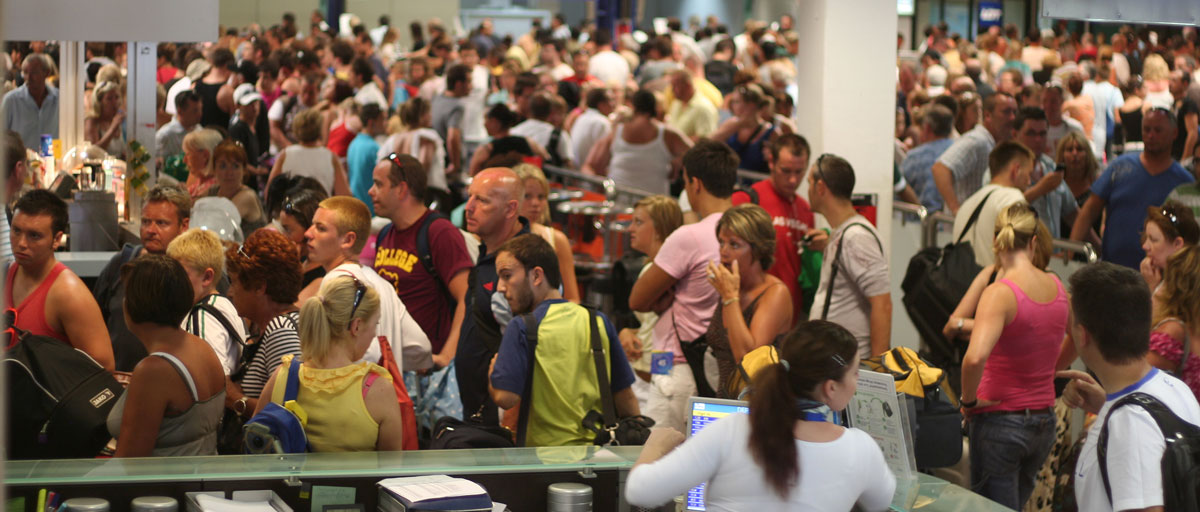
New study looks at what is driving infectious disease threat events in Europe. Travel is unsurprisingly a major driver and the authors suggest preventive solutions. Photo: Mark Hodson/Flickr and www.101holidays.co.uk
Bildtext får vara max två rader text. Hela texten ska högerjusteras om den bara ska innehålla fotobyline! Photo: B. Christensen/Azote
INFECTIOUS DISEASE THREAT EVENTS
It makes me feel sick...
New study examines where global infectious disease threat events come from
- New study examines infectious disease threat events (IDTE) in Europe
- The most prominent category driving IDTE is globalization and environment
- The top five drivers of IDTEs are tourism and travel, food and water quality, natural environment, and climate
In a highly connected world, we share a lot of positive things, like information or culture. But we also share germs, which are microbes, or insects and animals that are spreading them. While some microbes are harmless or help us, others are dangerous. They can give us food poisoning through eating E. coli infected food, or we can become infected with West Nile if bitten by an affected mosquito.
In our globalized world, it is also important to understand how harm like this gets around. In a paper recently published in Emerging infectious diseases centre researcher Elisabeth Lindgren and co-authors recently released a paper that explores just that: what is driving infectious disease threat events (IDTE) in Europe?
Listen to podcast of the article here
Travel and tourism
The study used 116 ITDE from 2008 to 2013 that met the criteria for inclusion in the study, based on information provided by the European Centre of Disease Prevention and Control. Using this information, the researchers were able to identify 17 drivers causing these IDTEs in Europe. They then categorized them into three categories: globalization and environment, sociodemographic, and public health systems.
Globalization and environment category were the most influential of IDTEs. Included in this category are the top five overall drivers of IDETs in Europe: tourism and travel, food and water quality, natural environment, and climate.
With more than 103 million people traveling in Europe in 2010 alone, it is perhaps not surprising that travel and tourism is the largest driver of IDTEs in Europe. It is both disconnected from all other drivers, but also is the most common way an IDTE starts. While limiting travel may seem like a solution, the authors highlight that it is both unrealistic and undesirable.
“Persons, services, goods, capital, and microbes are free to move across borders”
Co-author Elisabet Lindgren
Instead, Lindgren and co-authors suggest that a solution could be, “monitoring and modeling air traffic patterns for pathogen importation risk can potentially accelerate early case detection and rapid response and effective control of IDTEs.”
Monitoring and understanding changes to ecosystem habitats is also important for controlling outbreaks of IDTEs, and is the third most prominent driver found in the study.
“Changes in the natural environment and the climate that causes alterations of land cover and land use, with changes in biodiversity and habitats can all contribute to shifts in disease risk distribution, and influence abundance of vectors causing disease, such as rodents, mosquitoes, and ticks,” adds Lindgren.
Unhealthy relationships
To understand the relationships between IDTE drivers, Lindgren and colleagues used statistical technique cluster analysis. Simply put, cluster analysis allows us to understand which drivers are more similar to one another.
Through this technique, Lindgren and co-authors found that majority of IDTEs had at least two or three drivers. The most related drivers were climate and natural environment, as well as migration and social inequality. This suggests that these two relationships go hand in hand, and can reinforce each other in IDTEs.
With climate change contributing to habitat alterations, and with migrants most typically belong to more disadvantaged communities, a solution could aim to address both drivers to reduce similar future IDTEs.
However, addressing single drivers is also important too.
Lindgren concludes, “It is better to proactively prevent possible public health emergencies rather than respond to IDTE after they have occurred. The most cost-effective strategy would be to directly tackle the underlying drivers of an IDTE rather than deal with the actual IDTE after the fact. Intervening directly on drivers may prevent the occurrence of IDTEs and reduce the human and economic cost associated with IDTEs.”
Semenza, J.C., Lindgren, E., Balkanyi, L., Espinosa, L., Almqvist, M.S., Penttinen, P. and Rocklöv, J., 2016. Determinants and Drivers of Infectious Disease Threat Events in Europe. Emerging infectious diseases, 22(4), p.581.
Elisabet Lindgren is a board certified physician (Karolinska Institutet) and associate professor in Sustainability Science. She has a PhD in Natural Resources Management (Stockholm University), and is since 20 years specialized in health effects of global environmental changes, in particular climate change







